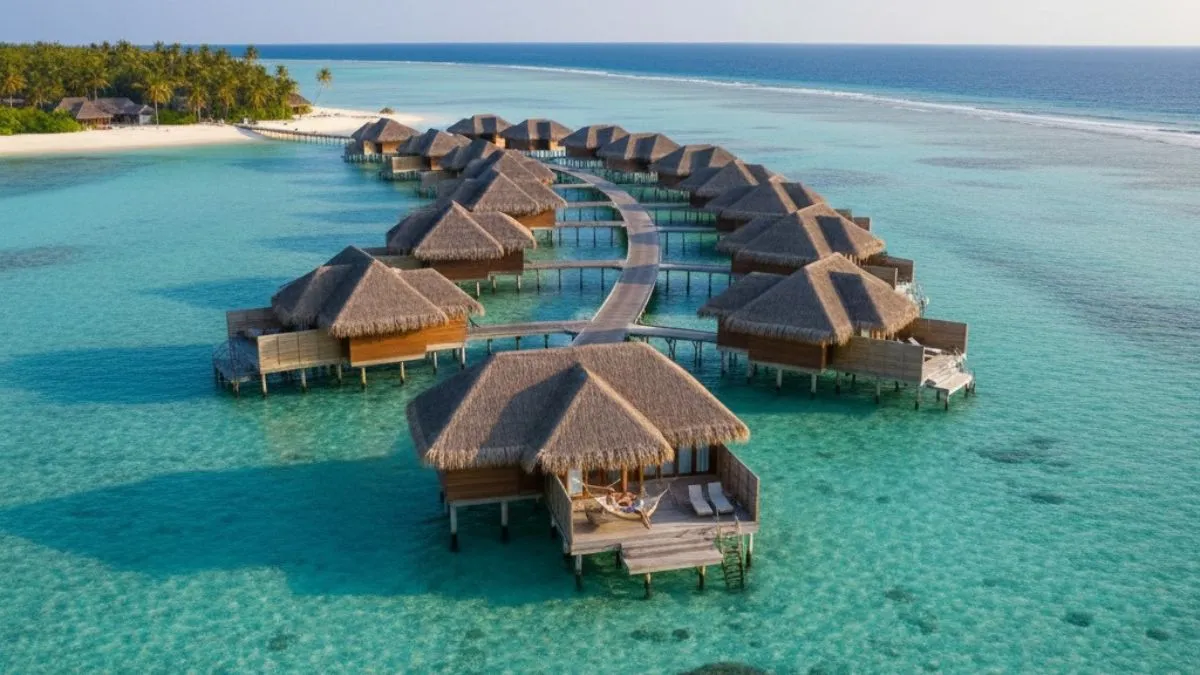The Maldives, an archipelago nation in the Indian Ocean, is globally synonymous with luxury, romance, and breathtaking natural beauty. Comprising 26 natural atolls and over 1,000 coral islands, it offers an unparalleled retreat with its iconic overwater bungalows, vibrant coral reefs, and powder-soft white sand beaches. This comprehensive guide provides everything you need to know for a seamless and unforgettable Maldivian getaway.
When to Visit: The Best Season for Your Maldives Holiday
The Maldives enjoys a tropical monsoon climate with high temperatures and a lot of sunshine year-round. The “best” time to visit largely depends on minimizing rain and maximizing sunlight.
| Aspect | Details |
| Best Season (Dry Season) | December to April |
| Why it’s Best | Lowest rainfall, low humidity, clear skies, and excellent visibility for diving and snorkeling. This is the peak season, leading to higher prices. |
| Shoulder Season | May and November |
| Wet Season (Monsoon) | May to October |
| Why to Consider Wet Season | Higher chance of rain and storms, but you often get long periods of sunshine. This is the low season, offering the best resort rates and fewer crowds. |
Maldives Administrative Atolls, Tourist Highlights, and Local Cuisine
The Maldives is administratively divided into 21 divisions (including four cities), which correspond to natural atolls or parts thereof. For tourists, the main appeal lies in a few key atolls. Note: Tourist resorts are typically located on their own private islands, separate from local-inhabited islands.
| Administrative Atoll (Key Tourism Areas) | Best Season to Visit | Top Tourist Spots / Activities | Famous Local Food |
| Kaafu Atoll (North/South Male Atoll, including Male City, Hulhumale) | Dec – April | Male City (Islamic Centre, Local Market), Hulhumale (Artificial Beach), Banana Reef (Diving), Luxury Resorts in North Male Atoll. | Mas Huni (Shredded smoked tuna, coconut, and chilli with flatbread-Roshi). |
| Alifu Atoll (North & South Ari Atoll) | Dec – April | Whale Shark and Manta Ray sightings (especially South Ari Atoll), World-class diving and snorkeling sites, luxurious resort islands. | Garudhiya (Clear fish broth/soup, usually tuna, served with rice, lime, and chilli). |
| Vaavu Atoll (Felidhoo Atoll) | Dec – April | Vaadhoo Island (Sea of Stars – bioluminescent plankton, though unpredictable), Fotteyo Kandu (Diving site), local island guesthouses. | Gulha (Small, deep-fried pastry balls filled with smoked tuna, coconut, and onion). |
| Addu City (Addu Atoll) | Jan – Mar | Gan Island (Historical World War II sites), Addu Scuba Diving (shipwrecks and vibrant reefs), Equatorial crossing line. | Addu Bondi (Sweet, sticky coconut ball snack). |
Famous Maldivian Cuisine (Dhivehi Food) Must-Try Dishes:
Maldivian food, or Dhivehi cuisine, is characterized by its use of three main ingredients: fish (especially tuna), coconut, and starches.
- Mas Huni: The most popular Maldivian breakfast, a mix of shredded smoked tuna, grated coconut, chopped onion, and chilli, often eaten with a flatbread called Roshi.
- Garudhiya: A traditional, clear fish broth (usually tuna) seasoned with salt and served with rice, lime, chili, and onions. It’s considered a staple.
- Mas Riha: A thick, flavorful fish curry (tuna) cooked with coconut milk, chillies, and a blend of aromatic spices.
- Bis Keemiya: A local version of a samosa/spring roll, which is a pastry filled with a mixture of tuna, hard-boiled egg, and gently sautéed shredded cabbage and onions.
- Saagu Bondibai: A popular sweet dessert made of sago (a type of palm starch) pudding with warm coconut milk, flavored with rosewater and cardamom.
What to Carry for Personal Hygiene and Comfort
While most resorts provide high-quality toiletries, due to the tropical environment and sun exposure, specific items are highly recommended for your well-being.
| Category | Recommended Items to Carry | Why You Need It |
| Sun Protection | High-SPF, reef-safe Sunscreen, SPF lip balm | Intense equatorial sun protection; reef-safe formulas protect coral. |
| After-Sun Care | Aloe Vera gel or After-sun lotion | Essential for soothing any sunburn or heat exposure. |
| Insect Repellent | Bug spray or mosquito repellent | Mosquitos can be present, especially around dusk and on local islands. |
| Medical/First Aid | Basic First Aid Kit (band-aids, antiseptic cream), motion sickness medication | For minor cuts from exploring/snorkeling; motion sickness pills are helpful for boat or seaplane transfers. |
| Personal Toiletries | Your preferred travel-sized shampoo, conditioner, body wash, deodorant, toothbrush/paste. | Resort toiletries may not suit your needs (e.g., hair care in high humidity). |
| Hydration | Reusable water bottle | To stay hydrated in the heat and reduce plastic waste. |
Affiliate Disclosure
This article may contain affiliate links, which means we may earn a small commission if you make a purchase through them, at no extra cost to you. We only recommend products and services we believe will add value to your trip.
Conclusion
The Maldives truly is a paradise that caters to all types of travelers, from luxury seekers and honeymooners to dedicated divers and budget travelers exploring local islands. By choosing the right season, knowing your administrative atolls, indulging in the unique flavors of Dhivehi cuisine, and packing appropriately for the tropical environment, you are guaranteed a journey that will leave you with memories of unparalleled beauty and tranquility. Get ready to trade your shoes for bare feet, your routine for relaxation, and your worries for the rhythmic sounds of the Indian Ocean.







